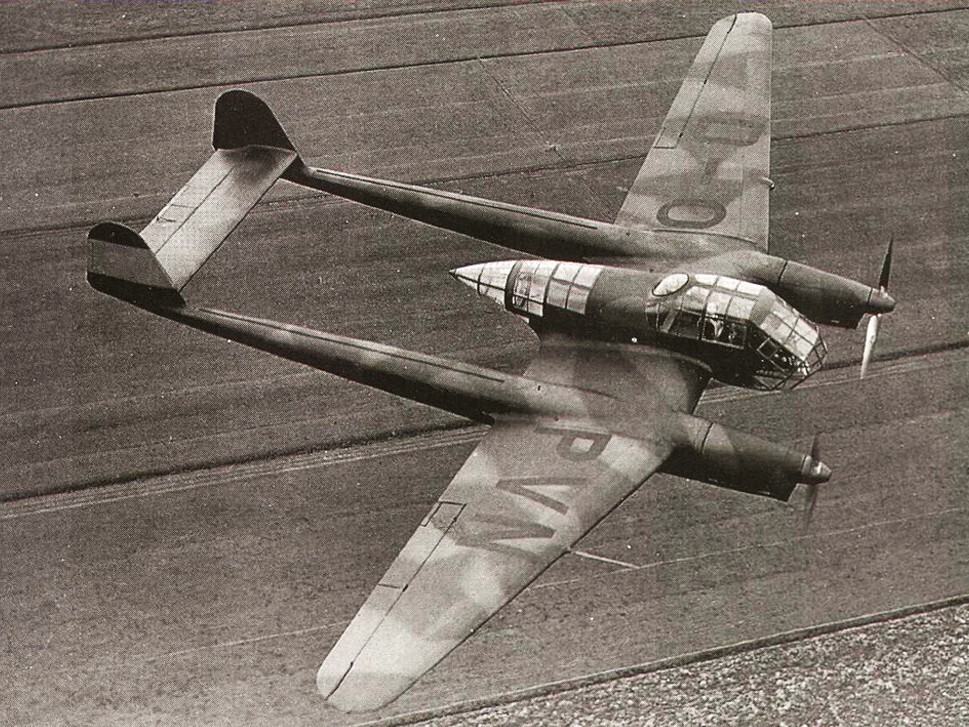- 13 Jan 2022
- AvBuyer
- GA Buyer Europe
Focke Wulf Fw 189: The Owl Left in the Woods
Few aircraft can be referred to as ‘the only one left’, but the Focke Wulf Fw 189 is. Follow the story, told by Ian Chalkley, including its rediscovery after 50 years lost in a Russian forest and restoration…
Back to Articles
The Fw 189 “Uhu” (Owl), is a German twin-engine, twin-boom, three-seat tactical reconnaissance and army cooperation aircraft. The aircraft’s origin came from the drawing board of Focke-Wulf’s chief designer himself, Kurt Tank. Here's it's story...
The test aircraft first flew in 1938 and production aircraft entered service in 1940 (and were produced until mid-1944). A total of 846 were built and the aircraft was used as the main reconnaissance aircraft of the German Army on the Eastern Front. Due to its success as an observation aircraft, it was known by many as ‘The Flying Eye’.
At Pontsalenjoki (on the fringe of the Russian Arctic Circle near the Finish border) on 4th May 1943, v7✚1H prepared for a photo reconnaissance mission to Loukhi. At 03.06 hrs the crew, Lothar Mothes (pilot), Kurt Lebrecht (senior officer/observer/mid-upper gunner), and Gunther Albrecht (rear gunner) took off on their last mission…never to return!
Some 50 years later and from deep inside a Russian forest, the aircraft was recovered by warbird specialist Jim Pearce (my Grandfather!). The aircraft was returned to the UK whereupon research and some initial pre-restoration work began. That fateful final mission was investigated and the pilot, Lothar Mothes, was not only found, but contact was established and he travelled to the UK to be reunited with his aircraft.
First Look at The Flying Eye
The Fw 189s were assembled at one of three production facilities: the Focke-Wulf factory in Bremen, Germany; at Avions Marcel Bloch’s factory in Bordeaux-Merignac (which was in occupied France but after the war became Dassault Aviation); or at the Aero Vodochody aircraft factory in Prague, (occupied) Czechoslovakia.
Total production was 864 aircraft. This aircraft was built in early 1941 by Aero in Prague where it was assembled as the fourth of only ten Fw 189s built there. The aircraft was assigned Werke Nr (S/N) 2100 and it was test flown, on the 23rd and 24th July 1941, by Aero test pilot Karel Vanek. It was released ‘airworthy’ and passed over to the short-range army cooperation unit.
The Fw 189 was designed to carry a crew of three, although at times it carried up to five. With a maximum speed of 217mph, it had an operating range of 416 miles. And it was a tough and rugged aircraft — on one occasion an Fw 189 returned after combat with one entire tail boom missing! This was caused either by flak or possibly even a ramming manoeuvre. This is testimony to the sturdiness of the design. For ease of replacement, both booms were interchangeable to minimise the number of spare parts needed.
The aircraft had, as part of its defensive armament design, an innovative rear gun station designed by the Ikaria Aeronautical Equipment Company. This included a rotating conical rear turret which was manually rotated within a metal-framed glazed conical fairing. This provided the operator an open section for either a single or twin-mount machine gun.
The unique design provided not just an effective weapons platform but was also a very well thought-through, streamlined shape, which complimented the aircraft’s manoeuvrability. Many pilots, including Mothes (the pilot of this one), commented on what good handling the aircraft had.
In the role that it was designed for, principally reconnaissance, it was regarded as a superb aircraft. The Fw 189 managed to combine all the attributes needed on the Eastern Front — strength, manoeuvrability, toughness and reliability — with the capacity to operate from short, rough airstrips.
The aircraft also carried underwing bomb racks, two on each wing. These were fitted so that the aircraft could carry four SC 50kg bombs. This aircraft was eventually stationed with 1 (H)/32 based at Pontsalenjoki, carrying the code letters ‘v7 ✚ 1H’. The ‘v7’ represented the squadron, the ‘1’ the unit, and the ‘H’ was the aircraft letter.
Last Mission
At Pontsalenjoki, on 4th May 1943, v7✚1H departed for a photo-reconnaissance mission to Loukhi. The task: To photograph Loukhi III Airbase from an altitude of 20,000ft and then continue north up the Murmansk-Leningrad Railway. At 03.06 the crew departed.
At exactly 03.37hrs, 31 minutes into the flight, a radio message was received at their base to say that after arriving over Loukhi they were under heavy attack by enemy fighters (Russian Hurricanes). This was the last radio message received from the aircraft.
Both the gunners were wounded during the air-to-air combat. The aircraft made a forced landing and struck the tops of trees before finally stopping, ‘elevated’, in the canopy of the forest, at which point it dropped down and backwards, dislodging the tail booms, before finally coming to rest upside down in the middle of a densely wooded area.
Lebrecht and Albrecht died as a result of their wounds, whereas Mothes survived after the landing. Mothes hid behind Russian lines for two weeks, living off grubs he found behind bark on the trees. He was eventually spotted and rescued by German soldiers. He spent nine months in hospital and convalescing as a result of the crash. But Mothes made a full recovery and returned to his duties as a pilot, flying a further 100 missions in Fw 189s.
Mothes survived the war and in later years worked as an architect in Germany. Following extensive research about the aircraft, he was located and invited to the UK during a large airshow in 1996 to be reunited with the aircraft some 53 years since he left it.
His visit caused total silence among the surrounding crowd, and he looked rather emotional as he surveyed the condition of the aircraft, undoubtedly remembering his fallen crewmates.
He took a moment to compose himself, walked up to the cockpit and, leaning in, he placed his hands on the throttles and commented “just where I left them!”
The FW 189 spent an extensive period of its untouched life in arctic conditions in the Murmansk region of Northern Russia. Jim Pearce, a warbird recovery specialist from the UK, inspected the aircraft ‘as found’ on the forest floor. Most moving components in the aircraft still moved.
This included the navigator/bomber’s swivel seat which still slid backwards and forwards.
Multiple other hatches could still be opened and operated with ease. Other than a local bear which took some interest in Jim’s presence, causing some concern he told me, the location remained an eerily still and timeless place.
The aircraft had a number of visible bullet holes, one of which had a clear line of fire from an acute angle from the starboard side fuselage skin near to the rear cone, and up over the pilot’s right shoulder. Another visible strike had come from the port quarter, which damaged at least one of the engines. The glazed canopy had also suffered heavy damage from aircraft combat firepower and the subsequent forced (crash) landing.
A very capable Russian team was assembled and tasked with extracting v7✚1H by helicopter. Following a challenging movement, the aircraft was transported back to the UK in 1992 by air, road and sea. The aircraft and squadron codes of v7✚1H were still clearly visible following the recovery and inspection in the UK.
Although 0112100 is the full works number, all the other plates on the aircraft, and especially the painted number on each fin, simply refer to ‘2100’. The clearest marking on the aircraft was found on one of the fins, which displayed a Swastika.
Other visible markings include a white stork which was displayed on both exterior sides of the cockpit. This was the emblem of the Unit the aircraft belonged to, 1(H)/32, a short-range army cooperation unit. The camouflage paint of the upper surfaces had been painted over in a whitewash for winter missions — this had been crudely brushed on by hand which is still clearly visible on the original surfaces today.
The Fw 189’s two Argus As 410A-1 12-cylinder inverted-vee air-cooled engines both had been broken at the firewall upon impact with the ground (after crashing into the forest canopy). Both engines were quite severely damaged, with one having taken a number of small-calibre hits to the engine casing. During the crash, both two-bladed wooden Argus propellers disintegrated.
Following recovery, Jim spent many years making painstaking progress preparing the aircraft for an eventual restoration. And in 2009 the aircraft was sold to a well-known collector in the USA.
The aircraft was shipped to their facility in Seattle, Washington. Shortly after its arrival, they asked Jim to come over and share his knowledge of the aircraft. I accompanied him on the trip.
Back in the UK and still evident on one of the wingtips were the main factory plates for the aircraft. This had been partly concealed by yellow theatre paint. It clearly states ‘Focke-Wulf Flugzeugbau GmbH, Bremen’; ‘Nachbau Aero’; ‘Prag-Praha’; Muster 189 and the full Werke Nr of 0112100.
The collector’s team had laid out all the parts (every single bit!) in isles, up and down a huge warehouse. We sat my grandfather on a wheelie office chair, armed him with a good English cup of tea, and literally rolled him up and down from isle to isle while he identified and described in detail each part.
Their team of engineers hurriedly made notes and could barely keep up with him. When he got going, his passion for aviation surpassed his age (around 80 at the time) and it was like chasing a kid around a sweet shop!
Following Jim’s visit the aircraft was placed into storage, alongside a few other WWII aircraft, awaiting its turn in the workshop. Some work was started a few years later in the USA and then the entire project was relocated to the UK and placed with world-renowned warbird specialists The Aircraft Restoration Company (‘ARCo’) at Duxford. And it could not have gone to a better home.
ARCo has a wealth of experience and specialist knowledge in working with warbirds. Since its arrival there, ARCo has done a tremendous job and has made not just excellent progress but has produced yet another example of outstanding craftsmanship.
At a Crossroads…
The aircraft is now at an advanced stage of restoration and is at a unique crossroads for the next owner, who will have the choice of whether to return the aircraft to static condition or to flying condition.
As the only surviving example of its kind, this Fw 189 is considered a rare piece indeed and would be the prized possession of many collectors.
It will be very exciting to follow its journey once more and to see where it ends up. I hope I get to see it fly one day!
Read more articles from Jamie Chalkley's excellent Historic Aircraft Series with GA Buyer Europe Online.
Related Articles
- 07 Dec 2021
- AvBuyer
- GA Buyer Europe
- 25 Nov 2021
- AvBuyer
- GA Buyer Europe
SHARE THIS ARTICLE
Other Articles
Featured Aircraft
Price entered as: £70,000 No VAT, Price Reduced
United Kingdom - England


